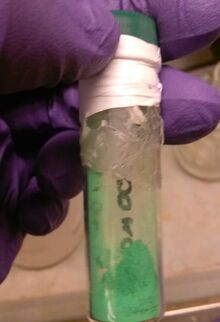Chemistry:Cobalt(II) bromide
 Structure of cobalt(II) bromide tetrahydrate
| |
 Crystal structure of cobalt(II) bromide
| |
 Anhydrous cobalt(II) bromide in a vial
| |
| Identifiers | |
|---|---|
3D model (JSmol)
|
|
| ChemSpider | |
| EC Number |
|
PubChem CID
|
|
| RTECS number |
|
| UNII | |
| UN number | 3077 |
| |
| |
| Properties | |
| CoBr2, CoBr2.6H2O, CoBr2.2H2O | |
| Molar mass | 218.7412 g/mol (anhydrous) 326.74 g/mol (hexahydrate) |
| Appearance | Bright green crystals (anhydrous) Red-purple crystals (hexahydrate) |
| Density | 4.909 g/cm3 (anhydrous) 2.46 g/cm3 (hexahydrate) |
| Melting point | 678 °C (1,252 °F; 951 K) (anhydrous) 47 °C (hexahydrate) |
| anhydrous: 66.7 g/100 mL (59 °C) 68.1 g/100 mL (97 °C) hexahydrate: 113.2 g/100 mL (20 °C) | |
| Solubility | 77.1 g/100 mL (ethanol, 20 °C) 58.6 g/100 mL (methanol, 30 °C) soluble in methyl acetate, ether, alcohol, acetone |
| +13000·10−6 cm3/mol | |
| Structure | |
| Rhombohedral, hP3, SpaceGroup = P-3m1, No. 164 | |
| octahedral | |
| Hazards | |
| Safety data sheet | Fisher Scientific |
| GHS pictograms |   
|
| GHS Signal word | Danger |
| H302, H312, H315, H317, H319, H332, H334, H335, H350 | |
| P201, P202, P261, P264, P270, P271, P272, P280, P281, P285, P301+312, P302+352, P304+312, P304+340, P304+341, P305+351+338, P308+313, P312, P321, P322, P330, P332+313, P333+313, P337+313, P342+311 | |
| NFPA 704 (fire diamond) | |
| Flash point | Non-flammable |
| Lethal dose or concentration (LD, LC): | |
LD50 (median dose)
|
406 mg/kg (oral, rat) |
| Related compounds | |
Other anions
|
cobalt(II) fluoride cobalt(II) chloride cobalt(II) iodide |
Other cations
|
iron(II) bromide nickel(II) bromide |
Except where otherwise noted, data are given for materials in their standard state (at 25 °C [77 °F], 100 kPa). | |
| Infobox references | |
Cobalt(II) bromide (CoBr2) is an inorganic compound. In its anhydrous form, it is a green solid that is soluble in water, used primarily as a catalyst in some processes.
Properties
When anhydrous, cobalt(II) bromide appears as green crystals. It is hygroscopic and eventually forms the hexahydrate in air,[1] which appears as red-purple crystals. The hexahydrate loses four water of crystallization molecules at 100 °C forming the dihydrate:
- CoBr2·6H2O → CoBr2·2H2O + 4 H2O
Further heating to 130 °C produces the anhydrous form:
- CoBr2·2H2O → CoBr2 + 2 H2O
The anhydrous form melts at 678 °C.[2][3] At higher temperatures, cobalt(II) bromide reacts with oxygen, forming cobalt(II,III) oxide and bromine vapor.
The tetrahydrate is molecular, with the formula trans-[CoBr2(H2O)4].[4]
Preparation and reactions
Cobalt(II) bromide can be prepared as a hydrate by the reaction of cobalt hydroxide with hydrobromic acid:
- Co(OH)2 + 2HBr → CoBr2·6H2O
The classical coordination compound bromopentaamminecobalt(III) bromide is prepared by oxidation of an aqueous solution of cobalt(II) bromide and ammonia.[5]
- 2 CoBr2 + 8 NH3 + 2 NH4Br + H2O2 → 2 [Co(NH3)5Br]Br2 + 2 H2O
Triphenylphosphine complexes of cobalt(II) bromide have been used as a catalysts in organic synthesis.[citation needed]
Safety
Exposure to large amounts of cobalt(II) can cause cobalt poisoning.[6] Bromide is also mildly toxic.
References
- ↑ Perry, Dale L. (2011). Handbook of Inorganic Compounds (2nd ed.). Boca Raton: Taylor & Francis. pp. 130. ISBN 978-1-4398-1461-1. OCLC 587104373. https://www.worldcat.org/oclc/587104373.
- ↑ Cobalt Bromide Supplier & Tech Info American Elements
- ↑ WebElements Periodic Table of the Elements
- ↑ Waizumi, Kenji; Masuda, Hideki; Ohtaki, Hitoshi (1992). "X-ray Structural Studies of FeBr2·4H2O, CoBr2·4H2O, NiCl2·4H2O and CuBr2·4H2O. Cis/Trans Selectivity in Transition Metal(II) Dihalide Tetrahydrate". Inorganica Chimica Acta 192 (2): 173–181. doi:10.1016/S0020-1693(00)80756-2.
- ↑ Diehl, Harvey; Clark, Helen; Willard, H. H.; Bailar, John C. (1939). "Bromopentamminocobalti Bromide". Inorganic Syntheses. Inorganic Syntheses. 1. pp. 186. doi:10.1002/9780470132326.ch66. ISBN 978-0-470-13232-6.
- ↑ "Cobalt Bromide (OUS)". http://www.chrismanual.com/C/COB.pdf.
 |


